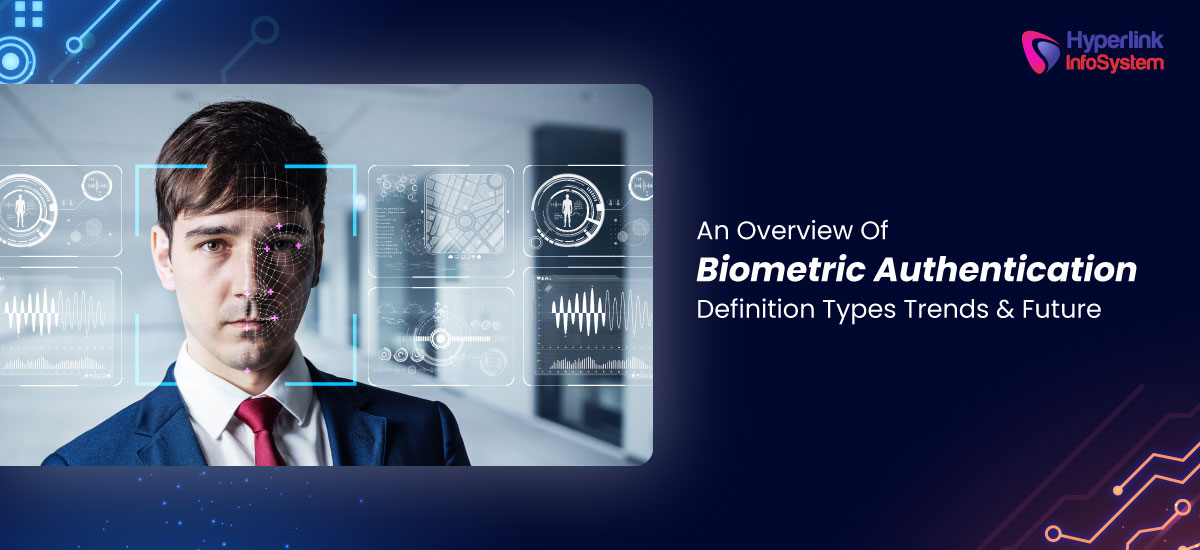The usage of biometric has increased and developed over the decade. The reason behind the increasing demand is its security and reliable services. Biometric authentication is a type of cybersecurity that verifies a user's identification by employing physical characteristics like a password. Biometric authentication systems compare a user's biometric mark to one tendered and put it in a database to assess whether the person, trying to log in or access any variety of data, signing up from another device, and much more. Biometric authentications tell us that it is that person or some breach into it.
Biometric authentication is a rapidly emerging technology that, when properly deployed, may help your company secure that only the appropriate employees have access to vital data. Here is what you require to know about biometric authentication, type, and the future of Biometric authentication.
Types of Biometric Authentication you must know:
You may have noticed them on a regular basis, but you may not be aware that they constitute a form of biometric authentication. It is nearly everywhere these days, as it has become a must for a company's security. Let's have a look on how significant biometrics authentication are in our daily lives.
1. Voice identification
Vocal recognition is a quick kind of biometric verification that uses an individual's particular voice patterns to verify their identity. This technology creates a voiceprint that is unique to each individual based on the underlying biological qualities of their voice. Because of its biometric elements, it is difficult to recognition voice recognition. It is, on the other hand, more user-friendly because it eliminates the need for users to remember passwords and security questions. Call centers aren't the only ones that use voice recognition. This approach is being used by mobile banking applications for increased mobile banking security.
2. Palm Recognition
A palm print identification system recognizes a person based on elements in their palmprint that may or may not be visible to the human eye.The physical pattern such as lines, texture, points, and others are there in the palm prints and it is what diverse them from others. The palm recognition is easy to use in techniques and with the fingerprint identification the accuracy recognition increases.
3. Face recognition
It is similar to palam and finger recognition. Iris scanning biometrics identify and validate one's identification by measuring the distinctive patterns in the colored circle of one's eye. Iris-based identification technologies are frequently employed as a physical access control modality, and they're ideal for high-throughput environments that need precision and speed.
4. Fingerprint identification
Fingerprint identification is the earliest of all of them. Because every fingerprint is different, the fingerprint is a particularly specific way of verifying a person. Even the identical twins does not have same fingerprints, thus it shows how different fingerprints are of every human. The fingerprints identification is quick and it also help to match with previous record or information. The different fingerprints makes the work more smooth and rapid. Now, the finger identification system is increasing because of the latest technology and high used of the system in corporate houses, malls, buildings, and more.
5. Vein Recognition
Vein recognition employs a person's hand's or finger's unique pattern of blood veins to identify them. It maps the veins beneath the skin of your hands or fingers using infrared light. Vein recognition is one of the most advanced biometric identification methods available today.
The Biometric Authentication Trends to Follow:
Mobile Biometric
Biometric device development trends point to a large reduction in this sort of device and improved simplicity of use. The active use of smartphones with pre-installed sensors is connected with the growth of the mobile biometrics market segment. At the same time, biometric characteristics will be utilized for authentication not only to unlock mobile devices but also to organize multi-factor authentication and quick confirmation of electronic payments.
Biometric Single Sign-On Services
Biometric single sign-on technology allows users to access all authorized IT resources and systems with a single identification. The user just needs to submit authentication data by doing the actions that correspond to the techniques used: placing their finger on the reader, passing through facial recognition, or saying a key phrase that will be selected by voice. For example, after passing the operating system's authentication procedure, the user gains automatic access to a variety of programs without having to repeatedly enter their account information.
Authentication tools
In the usage of authenticating devices, there are two main biometric trends. The first trend is multimodal biometric authentication, in which numerous biometric technologies are employed simultaneously rather than just one. The use of a personal device as a biometric access token is the second option. A camera and a microphone are standard features on all current smartphones. Many include a fingerprint scanner; for example, Samsung's flagship device has an iris scanner.
Future of Biometric Authentications:
Many biometric services are being developed and tested right now. However, these biometric technologies will be widely used in a few years. Plastic cards will soon fade into the background, and fingerprint scans will become a commonplace procedure.
The public perception of biometrics appears to be a concern. You have fingers, eyes, and a face, as everyone knows. Every imaginable attribute is being studied, from heart rate monitoring to implanting chips under your skin, as well as examining intraocular veins, the structure of your earlobes, and more. Simplicity is going to be the key to biometric security in the future. The simplest technique to provide a high level of protection is to improve modern methods. You can, for example, scan a 3D image of a fingerprint and examine every detail.
Biometric identification technologies are evolving at such a rapid pace that predicting what they will look like in a few years is challenging. One thing can be assumed with certainty: passwords that are difficult to use, modify, and remember will stay a thing of the past.
Final Words
Biometric authentication is becoming more popular as a result of its convenience, adaptability, and other advantages over standard usernames and passwords. You now have a better understanding of the many forms of biometric authentication technologies as well as the benefits of biometric systems.
 +1 309 791 4105
+1 309 791 4105




















































 +91 8000 161161
+91 8000 161161
